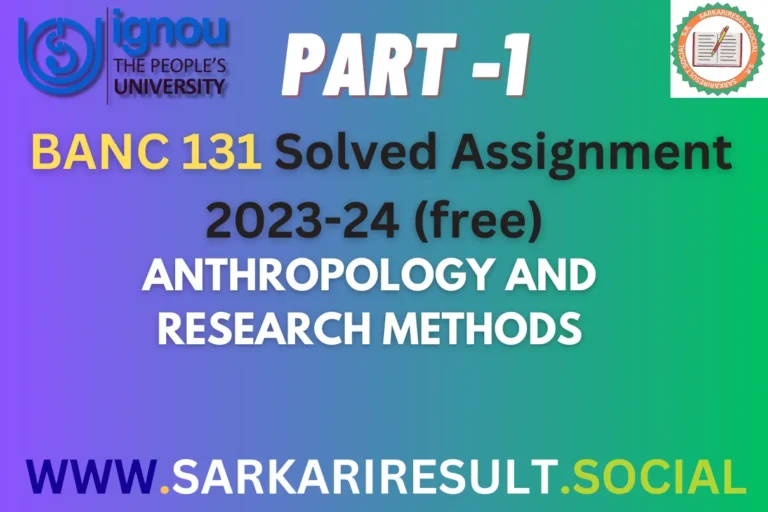BABG 171 SOLVED IGNOU ASSIGNMENT FREE PART 2

Dive into the depths of Assignment-II for BABG 171 SOLVED IGNOU ASSIGNMENT FREE PART 2: Understanding B.R. Ambedkar. Unravel the nuances of Ambedkar’s contribution to gender equality in India and his insightful perspectives on untouchability. Answer each question thoughtfully, providing approximately 250 words for a concise yet comprehensive response. Additionally, grasp the economic intricacies with a discussion on the gold exchange standard and its distinctions from the gold standard. Elevate your understanding and academic performance with our meticulously crafted IGNOU Solved Assignments 2024.

Answer the following questions in about 250 words each.
Q.3 Explain Ambedkar’s contribution towards gender equality in India.
Ans. Dr. B.R. Ambedkar, while primarily known for his monumental contributions towards social justice and the upliftment of marginalized communities, also made significant strides in advocating for gender equality in India. His vision extended beyond caste issues to encompass the broader framework of societal inequalities, including those faced by women. Here are some aspects of Ambedkar’s contribution to gender equality:
1. Women’s Rights in the Constitution:- As the principal architect of the Indian Constitution, Ambedkar played a pivotal role in enshrining fundamental rights for all citizens, regardless of gender. The Constitution guarantees equality before the law (Article 14), prohibits discrimination on grounds of sex (Article 15), and ensures equal opportunities in public employment (Article 16).
2. Support for Women’s Education:- Ambedkar recognized the transformative power of education. He advocated for women’s education as a means to empower them and break the shackles of societal norms. Education, in his vision, was a tool for women to assert their rights and participate meaningfully in societal progress.
3. Legal Reforms:- Ambedkar was instrumental in pushing for legal reforms that addressed discriminatory practices against women. He actively supported laws that aimed at protecting women’s rights, including those related to marriage, inheritance, and property rights.
4. Equal Political Representation:- Ambedkar emphasized the importance of political empowerment for women. While drafting the Constitution, he ensured that it provided for equal political representation, paving the way for women to participate in the democratic process.
5. Opposition to Patriarchy:- Ambedkar was a vocal critic of patriarchy and its oppressive impact on women. He sought to challenge traditional norms that restricted women’s autonomy and hindered their progress. Ambedkar’s writings and speeches reflect his commitment to dismantling patriarchal structures.
6. Women’s Rights Activism:- Ambedkar’s influence extended to inspiring women’s rights activists. Many prominent women leaders, including Dr. Ambedkar’s wife Savitribai Phule and Dr. Ambedkar’s contemporary, Fatima Sheikh, were active in advocating for women’s rights based on the principles of social justice.
Ambedkar’s multifaceted contributions to gender equality laid the groundwork for the subsequent women’s rights movements in India. His commitment to creating a just and egalitarian society encompassed the inclusion of women in the larger project of social reform and progress. While challenges persist, Ambedkar’s principles continue to guide discussions on gender equality and women’s rights in India.
Q.4 Discuss Ambedkar’s understanding of untouchability.
Ans. Dr. B.R. Ambedkar, a visionary leader and social reformer, had a profound understanding of untouchability, a deeply ingrained practice in the caste system that relegated certain communities to the status of “untouchables.” His insights into untouchability were instrumental in shaping his lifelong struggle for social justice. Here are key aspects of Ambedkar’s understanding of untouchability:
1. Rooted in the Caste System:- Ambedkar saw untouchability as a byproduct of the caste system, where individuals were assigned positions in a rigid hierarchical order based on their birth. The untouchables, or Dalits, were placed at the lowest rungs of this hierarchy, subjected to discrimination and exclusion.
2. Social Exclusion and Discrimination:- Untouchability manifested as a form of social exclusion and discrimination, denying the untouchables access to various aspects of social life, including education, public spaces, and temples. It was not merely an economic or occupational issue but a deeply entrenched social and cultural practice.
3. Economic Exploitation:- Ambedkar recognized that untouchables faced economic exploitation due to their marginalized status. Denied access to land and opportunities, they were often relegated to menial and degrading occupations, perpetuating a cycle of poverty.
4. Religious Justifications:- Religious scriptures were often misinterpreted to justify untouchability. Ambedkar vehemently criticized such interpretations and argued that religious practices should not be a source of discrimination and degradation.
5. Annihilation of Caste:- Ambedkar’s seminal work, “Annihilation of Caste,” delves into the root causes of untouchability and advocates for its complete eradication. He called for a radical restructuring of society that transcended caste divisions, emphasizing inter-caste marriages and breaking down barriers that perpetuated untouchability.
6. Political and Legal Struggle:- Ambedkar’s understanding of untouchability informed his political and legal struggle for the rights of Dalits. He played a crucial role in framing laws that sought to eliminate untouchability and uplift the marginalized communities.
7. Education as Empowerment:- Ambedkar viewed education as a powerful tool for the empowerment of the untouchables. He believed that education could challenge social norms, raise awareness, and uplift individuals, enabling them to break free from the chains of untouchability.
8. Social Equality and Human Dignity:- Central to Ambedkar’s understanding was the quest for social equality and human dignity. He emphasized that untouchables should be treated as equals, entitled to the same rights and respect as any other member of society.
Ambedkar’s comprehensive understanding of untouchability was not merely theoretical; it was a driving force behind his relentless efforts to challenge and dismantle this deeply entrenched social evil. His advocacy for social justice, equality, and the annihilation of caste continues to inspire movements for the rights and dignity of marginalized communities in India.
Q.5 What is the gold exchange standard? How is it different from the gold standard?
Ans. The gold exchange standard and the gold standard are both monetary systems that link the value of a country’s currency to a specific quantity of gold. However, they differ in their operational mechanisms and the role of gold in international trade.
Gold Standard:
Under the gold standard, countries directly pegged their currencies to a specific quantity of gold. Each unit of currency had a fixed exchange rate with a specific amount of gold. Countries held gold reserves to back the value of their currency. This system provided stability and predictability to international trade but had limitations, especially during economic downturns when the money supply could not be easily adjusted.
Gold Exchange Standard:
The gold exchange standard, developed as a modification to the gold standard, emerged in the interwar period (1920s and 1930s). In this system, countries held their reserves not only in gold but also in the currencies of other nations, particularly those considered strong and stable. The U.S. dollar became a primary reserve currency. The idea was that holding currencies backed by gold provided flexibility and liquidity to the international monetary system.
Key Differences:
1. Reserve Currencies: In the gold exchange standard, reserve currencies (like the U.S. dollar) played a crucial role alongside gold reserves. Countries held reserves in both gold and certain foreign currencies. In contrast, the gold standard relied solely on gold reserves.
2. Flexibility: The gold exchange standard offered more flexibility because countries could hold reserves in currencies that were easily exchangeable. This allowed for adjustments in response to economic conditions, a feature lacking in the rigid gold standard.
3. Adjustment Mechanisms: The gold exchange standard attempted to address some of the shortcomings of the gold standard by incorporating mechanisms that allowed countries to adjust their reserves in response to economic changes. This was particularly relevant during times of economic crises.
4. Global Imbalances: The gold exchange standard aimed to mitigate global imbalances by allowing countries to hold reserves in major currencies, promoting stability in international trade.
Both systems faced challenges, and the gold exchange standard eventually collapsed during the Great Depression. The Bretton Woods system, established after World War II, replaced it, introducing a new international monetary order that relied on the U.S. dollar as the primary reserve currency. The Bretton Woods system itself eventually gave way to the current system of floating exchange rates, where currencies are not directly linked to gold or other fixed standards.
Also See This: BABG 171 SOLVED IGNOU ASSIGNMENT FREE PART 3







